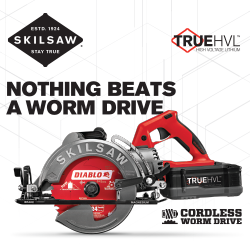
Potato patato what’s the different right? Well depending on the tool and what job you want to do there is going to be a lot of difference among these tools. We’ll go over some of the basics of how the different tools operate and some of the most common jobs for each. Hopefully we can clear up any confusion that might still be out there.
Traditional Drill/Driver
They’ve been around since the invention of power tools and my guess is if you are reading this blog you have several of these traditional drill/drivers in your possession already. Typically there tools will come with a 3/8” or ½” chuck and can vary greatly in speed, power and size. The traditional drill/driver is a very versatile tool because it can do two very common tasks drilling holes and driving fasteners. When you get to larger units like the very popular Milwaukee Hole Hawg ($279, Ohio Power Tool) and the torque rating starts to get pretty high the unit can become more difficult to control. Sometimes spinning the tool instead of the bit and people can get injured, because of this fact there is an upper limit on how much torque these tools can effectively have.
Impact Driver
Increasing in popularity the impact driver is similar to the more traditional drill/driver with the added feature in the impact gear mechanism. Once the motor reaches a certain level of resistance an impact gear kicks in and pounds an anvil in the same direction the motor is already spinning. This gives the motor a boost in torque and since the anvil is hit at a rate of around 3000bpm (or 50 times per second) the added torque feels very constant. The added benefit of this very rapid on/off of torque is that if the bit should be jammed you are not going to feel the twisting on your wrist like you do with a traditional drill. The impact drivers uses a hex shank which does limit the ability to use drill bits or 2 sided driver bits. More power and more control make these tools ideal for driving screws, bolts and other fasteners. Less ideal for finished woodworking as the impact mechanism can kick in at any point and will offer slightly less control in that sense compared to a traditional drill. The Bosch Impactor 26618 ($369, Ohio Power Tool) gives you the best of both worlds which can switch between drill and impact driver, however at that price you can also pick up a 2 tool kit with both tools (see CLPK22-180).
Hammer Drill
Similar again to the traditional Drill/Driver, most hammer drills will feature a ½” chuck and will be able to switch from drill mode to hammer drill mode. The “hammer” action can be attributed to a special clutch which will deliver around 30,000bpm (500 per second) which is a hard to imagine number. The hammer action actually moved the chuck in and out unlike the impact driver which advances the bit in the same way as the motor is already spinning. The rapid in and out motion pounds the material breaking it up while it drills, most effectively used on concrete and masonry. The hammer action is not intended for driving fasteners or use on wood, metal or any other materials. The hammer drill is commonly found in many combo kits but the downside is these tools are often much heavier than traditional drill/drivers or impact drivers and for most users this is a waist as they are going to be used in drill mode more often.
Rotary Hammer Drill
When you step up to a rotary hammer drill there is no longer fastener driving taking place. These larger drills hammering action is attributed to a piston mechanism instead of a clutch so the stroke is longer, more powerful but there are less of them. The rotary hammers also use special shanks to hold the carbide bits in place (see the post SDS vs SDS-Plus vs SDS-Max vs Spline) depending on the size of the hammer. Most commonly rotary hammers have 3 modes: drill only, hammer drill and hammer only. Hammer only mode allows for the use of chisels and scraper bits as well, adding some versatility to these tools. The most common application is for drilling holes into concrete from tapcon sizes up to 2” wide for anchoring structural rebar. Core bit (see Hammer Drill Core Bits) drilling ranging in size up to 6” are another common application for going into concrete, cinder block and other masonry.
Hopefully this helps clear up some of the confusion but if you still have questions about any of the tools or accessories please give the guys at Ohio Power Tool a call, 800-242-4424. They will help you find the right tool for the job.



